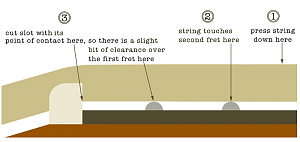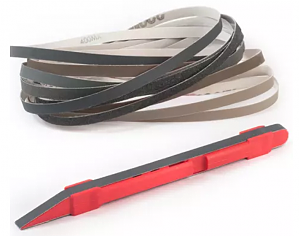Continued from previous post
NUT
Guitar
There seem to be two ways of setting the string height at the nut. One is the “Carruthers” approach, which is to measure the string height over the first fret, with no capo or string depressed anywhere. This approach is dependent on having all the other steps completed. You only want to do this after doing a complete setup with a neck that has been leveled. Carruthers sets it at .018 (.457mm)
An alternative used by a number of folks on the PB forum is essentially the approach referred to as “basic” on the Bryan Kimsey website:
http://www.bryankimsey.com/nuts/nuts3.htm
In this post the capo (or finger) goes on the third fret, and measurement is between the string and the 1st fret. One nice thing about this approach is that it takes action and relief measurements out of the equation. Pressing the string at the third fret means the string will touch the second fret. The idea is to get the clearance over the first fret to be as small as possible without touching the first fret, with the string touching the 2nd fret.
There is a nice graphic of how to do this on the Lutherie.net website:

One of our forum members who uses this approach has supplied some clearance measurements for between the first fret and string:

Originally Posted by
McCreed

I find the "basic method" as he calls it, works just fine. To each his own.
Whilst nut work requires practice to get consistent results and learn what not to do, it isn't rocket science.
If I'm cutting a nut from scratch or starting with a pre-slotted blank, I do use feeler gauges for roughing in. Again, this is what works for me.
My gap targets (with capo on 3rd fret) are .008" E6 & A; .006" D & G; .004" B & E1. I know that doesn't create a perfect radius, but I've never had a complaint from a customer or problem on my own guitars using those measurements.
FWIW, when I first started doing nut slots I did step them evenly (.008"/.007"/.006" etc.) but I didn't notice a difference between that and my current method.
I use the Carruthers approach on the first couple of strings to get close, and then switch to the “basic” approach using McCreed’s measurements. After the first two strings, I stop using the Carruthers approach and just go with the basic/McCreed approach.
Bryan Kemsey’s webpage suggests yet another approach…which I don’t know anyone who has tried, so I have no official opinion on it ;-)
Bass
I have really only used the Carruthers measurements with bass. These measurements are from the bottom of the string to the top of the fret.
Resting on bench (not playing positon)
All strings to .022” (.559mm)
It is hard to find measurements for the capo-3rd-fret method, although it is also used quite a bit. Measurements for that approach tend to be vague, like “about a piece of paper.” This is a little better from Lutherie.net (http://www.lutherie.net/nuts.html) where they say that the clearance should be the same at the first fret with the string depressed at the 3rd fret as it is one fret up from any depressed fret on the instrument.
“If you hold any string down on any fret of a well set up instrument, you'll see that same preferred clearance at the next fret up.”
Ian Partanen at Bassox.com recommends between .004 and .005 (.1 to .13 mm) (https://www.bassox.com/bass-guitar-nut-height/) He also notes that this is about the same as a piece of paper or a dollar bill US. Maybe a touch higher (.008?) on the E-string.
Before buying a feeler gauge you may want to make sure it has the sizes you need. Not all include blades this small.
NOODLE
The other “N” that you see folks use with the TRAIN acronym is “Noodle.” This is a way of saying that you may want to make some adjustments once you have finished a basic setup so that the guitar/bass conforms to your preferences. I am getting a bit more confident about tweaking settings after the initial setup as I do more of them. The one caution (courtesy of Simon) relates to the nut. You can adjust a nut to make it deeper, but if you cut it too deep you adjust it by knocking it out and replacing it.
One small tip. If I hear buzzing, I’ll also sometimes do micro adjustments (as in just under one string) using a fret dressing stick with 320 grit. These are sometimes called sanding or detailing sticks.

Pickup Height
The one bit of setup not in TRAIN is pickup height. I don’t have any great insight into this. I try to set at roughly the mfg specification, and then make adjustments for balance (with multi pickup guitars) or practicality. An example of the latter is with rail pickups. With factory specs on a bass, a slap was causing the string to hit the rail. On a guitar my palm sometimes touched both rails and I got a little buzz. In both cases Adjusting them down a little made a world of difference.
Hopefully others will chime in with their approaches!






 Reply With Quote
Reply With Quote


